
- •Preface
- •About This Book
- •Acknowledgments
- •Contents at a Glance
- •Contents
- •Relaxing at the Beach
- •Dressing the Scene
- •Animating Motion
- •Rendering the Final Animation
- •Summary
- •The Interface Elements
- •Using the Menus
- •Using the Toolbars
- •Using the Viewports
- •Using the Command Panel
- •Using the Lower Interface Bar Controls
- •Interacting with the Interface
- •Getting Help
- •Summary
- •Understanding 3D Space
- •Using the Viewport Navigation Controls
- •Configuring the Viewports
- •Working with Viewport Backgrounds
- •Summary
- •Working with Max Scene Files
- •Setting File Preferences
- •Importing and Exporting
- •Referencing External Objects
- •Using the File Utilities
- •Accessing File Information
- •Summary
- •Customizing Modify and Utility Panel Buttons
- •Working with Custom Interfaces
- •Configuring Paths
- •Selecting System Units
- •Setting Preferences
- •Summary
- •Creating Primitive Objects
- •Exploring the Primitive Object Types
- •Summary
- •Selecting Objects
- •Setting Object Properties
- •Hiding and Freezing Objects
- •Using Layers
- •Summary
- •Cloning Objects
- •Understanding Cloning Options
- •Mirroring Objects
- •Cloning over Time
- •Spacing Cloned Objects
- •Creating Arrays of Objects
- •Summary
- •Working with Groups
- •Building Assemblies
- •Building Links between Objects
- •Displaying Links and Hierarchies
- •Working with Linked Objects
- •Summary
- •Using the Schematic View Window
- •Working with Hierarchies
- •Setting Schematic View Preferences
- •Using List Views
- •Summary
- •Working with the Transformation Tools
- •Using Pivot Points
- •Using the Align Commands
- •Using Grids
- •Using Snap Options
- •Summary
- •Exploring the Modifier Stack
- •Exploring Modifier Types
- •Summary
- •Exploring the Modeling Types
- •Working with Subobjects
- •Modeling Helpers
- •Summary
- •Drawing in 2D
- •Editing Splines
- •Using Spline Modifiers
- •Summary
- •Creating Editable Mesh and Poly Objects
- •Editing Mesh Objects
- •Editing Poly Objects
- •Using Mesh Editing Modifiers
- •Summary
- •Introducing Patch Grids
- •Editing Patches
- •Using Modifiers on Patch Objects
- •Summary
- •Creating NURBS Curves and Surfaces
- •Editing NURBS
- •Working with NURBS
- •Summary
- •Morphing Objects
- •Creating Conform Objects
- •Creating a ShapeMerge Object
- •Creating a Terrain Object
- •Using the Mesher Object
- •Working with BlobMesh Objects
- •Creating a Scatter Object
- •Creating Connect Objects
- •Modeling with Boolean Objects
- •Creating a Loft Object
- •Summary
- •Understanding the Various Particle Systems
- •Creating a Particle System
- •Using the Spray and Snow Particle Systems
- •Using the Super Spray Particle System
- •Using the Blizzard Particle System
- •Using the PArray Particle System
- •Using the PCloud Particle System
- •Using Particle System Maps
- •Controlling Particles with Particle Flow
- •Summary
- •Understanding Material Properties
- •Working with the Material Editor
- •Using the Material/Map Browser
- •Using the Material/Map Navigator
- •Summary
- •Using the Standard Material
- •Using Shading Types
- •Accessing Other Parameters
- •Using External Tools
- •Summary
- •Using Compound Materials
- •Using Raytrace Materials
- •Using the Matte/Shadow Material
- •Using the DirectX 9 Shader
- •Applying Multiple Materials
- •Material Modifiers
- •Summary
- •Understanding Maps
- •Understanding Material Map Types
- •Using the Maps Rollout
- •Using the Map Path Utility
- •Using Map Instances
- •Summary
- •Mapping Modifiers
- •Using the Unwrap UVW modifier
- •Summary
- •Working with Cameras
- •Setting Camera Parameters
- •Summary
- •Using the Camera Tracker Utility
- •Summary
- •Using Multi-Pass Cameras
- •Creating Multi-Pass Camera Effects
- •Summary
- •Understanding the Basics of Lighting
- •Getting to Know the Light Types
- •Creating and Positioning Light Objects
- •Viewing a Scene from a Light
- •Altering Light Parameters
- •Working with Photometric Lights
- •Using the Sunlight and Daylight Systems
- •Using Volume Lights
- •Summary
- •Selecting Advanced Lighting
- •Using Local Advanced Lighting Settings
- •Tutorial: Excluding objects from light tracing
- •Summary
- •Understanding Radiosity
- •Using Local and Global Advanced Lighting Settings
- •Working with Advanced Lighting Materials
- •Using Lighting Analysis
- •Summary
- •Using the Time Controls
- •Working with Keys
- •Using the Track Bar
- •Viewing and Editing Key Values
- •Using the Motion Panel
- •Using Ghosting
- •Animating Objects
- •Working with Previews
- •Wiring Parameters
- •Animation Modifiers
- •Summary
- •Understanding Controller Types
- •Assigning Controllers
- •Setting Default Controllers
- •Examining the Various Controllers
- •Summary
- •Working with Expressions in Spinners
- •Understanding the Expression Controller Interface
- •Understanding Expression Elements
- •Using Expression Controllers
- •Summary
- •Learning the Track View Interface
- •Working with Keys
- •Editing Time
- •Editing Curves
- •Filtering Tracks
- •Working with Controllers
- •Synchronizing to a Sound Track
- •Summary
- •Understanding Your Character
- •Building Bodies
- •Summary
- •Building a Bones System
- •Using the Bone Tools
- •Using the Skin Modifier
- •Summary
- •Creating Characters
- •Working with Characters
- •Using Character Animation Techniques
- •Summary
- •Forward versus Inverse Kinematics
- •Creating an Inverse Kinematics System
- •Using the Various Inverse Kinematics Methods
- •Summary
- •Creating and Binding Space Warps
- •Understanding Space Warp Types
- •Combining Particle Systems with Space Warps
- •Summary
- •Understanding Dynamics
- •Using Dynamic Objects
- •Defining Dynamic Material Properties
- •Using Dynamic Space Warps
- •Using the Dynamics Utility
- •Using the Flex Modifier
- •Summary
- •Using reactor
- •Using reactor Collections
- •Creating reactor Objects
- •Calculating and Previewing a Simulation
- •Constraining Objects
- •reactor Troubleshooting
- •Summary
- •Understanding the Max Renderers
- •Previewing with ActiveShade
- •Render Parameters
- •Rendering Preferences
- •Creating VUE Files
- •Using the Rendered Frame Window
- •Using the RAM Player
- •Reviewing the Render Types
- •Using Command-Line Rendering
- •Creating Panoramic Images
- •Getting Printer Help
- •Creating an Environment
- •Summary
- •Creating Atmospheric Effects
- •Using the Fire Effect
- •Using the Fog Effect
- •Summary
- •Using Render Elements
- •Adding Render Effects
- •Creating Lens Effects
- •Using Other Render Effects
- •Summary
- •Using Raytrace Materials
- •Using a Raytrace Map
- •Enabling mental ray
- •Summary
- •Understanding Network Rendering
- •Network Requirements
- •Setting up a Network Rendering System
- •Starting the Network Rendering System
- •Configuring the Network Manager and Servers
- •Logging Errors
- •Using the Monitor
- •Setting up Batch Rendering
- •Summary
- •Compositing with Photoshop
- •Video Editing with Premiere
- •Video Compositing with After Effects
- •Introducing Combustion
- •Using Other Compositing Solutions
- •Summary
- •Completing Post-Production with the Video Post Interface
- •Working with Sequences
- •Adding and Editing Events
- •Working with Ranges
- •Working with Lens Effects Filters
- •Summary
- •What Is MAXScript?
- •MAXScript Tools
- •Setting MAXScript Preferences
- •Types of Scripts
- •Writing Your Own MAXScripts
- •Learning the Visual MAXScript Editor Interface
- •Laying Out a Rollout
- •Summary
- •Working with Plug-Ins
- •Locating Plug-Ins
- •Summary
- •Low-Res Modeling
- •Using Channels
- •Using Vertex Colors
- •Rendering to a Texture
- •Summary
- •Max and Architecture
- •Using AEC Objects
- •Using Architectural materials
- •Summary
- •Tutorial: Creating Icy Geometry with BlobMesh
- •Tutorial: Using Caustic Photons to Create a Disco Ball
- •Summary
- •mental ray Rendering System
- •Particle Flow
- •reactor 2.0
- •Schematic View
- •BlobMesh
- •Spline and Patch Features
- •Import and Export
- •Shell Modifier
- •Vertex Paint and Channel Info
- •Architectural Primitives and Materials
- •Minor Improvements
- •Choosing an Operating System
- •Hardware Requirements
- •Installing 3ds max 6
- •Authorizing the Software
- •Setting the Display Driver
- •Updating Max
- •Moving Max to Another Computer
- •Using Keyboard Shortcuts
- •Using the Hotkey Map
- •Main Interface Shortcuts
- •Dialog Box Shortcuts
- •Miscellaneous Shortcuts
- •System Requirements
- •Using the CDs with Windows
- •What’s on the CDs
- •Troubleshooting
- •Index
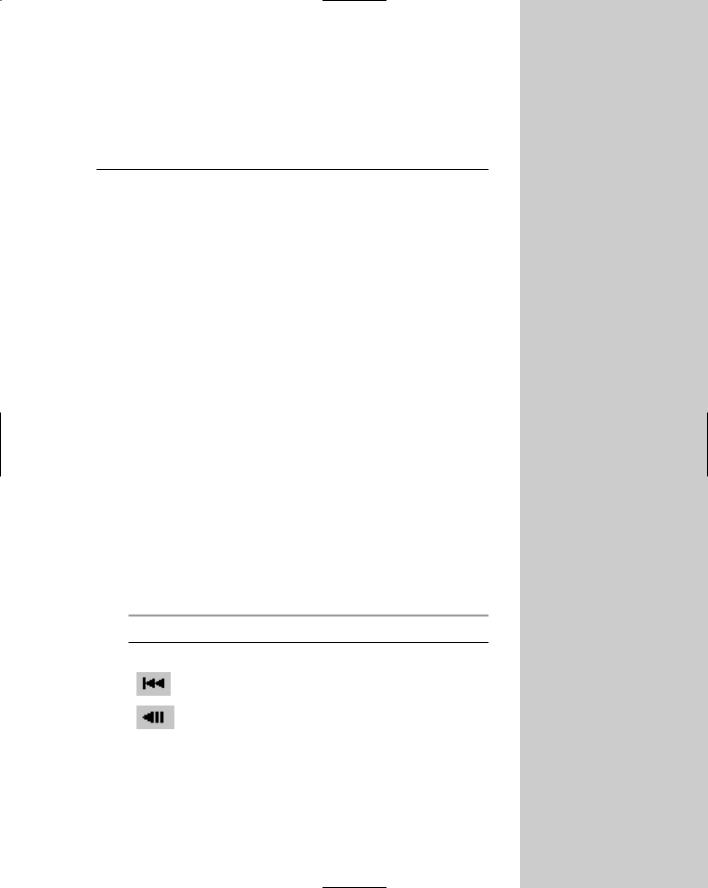
Animation Basics
Max can be used to create some really amazing images, but I bet more of you go to the movies than to see images in a museum.
The difference is in seeing moving images versus static images.
In this chapter, we start discussing what is probably one of the main reasons you decided to learn 3ds max in the first place — animation. Max includes many different tools to create animations. This chapter covers the easiest and most basic of these tools.
Using the Time Controls
Before jumping into animation, you need to understand the controls that make it possible. These controls collectively are called the Time Controls and can be found on the lower interface bar between the key controls and the Viewport Navigation Controls. The Time Controls also include the Time Slider found directly under the viewports.
The Time Slider provides an easy way to move through the frames of an animation. To do this, just drag the Time Slider button in either direction. The Time Slider button is labeled with the current frame number and the total number of frames. The arrow buttons on either side of this button work the same as the Previous and Next Frame (Key) buttons.
The Time Control buttons include buttons to jump to the Start or End of the animation, or to step forward or back by a single frame. You can also jump to an exact frame by entering the frame number in the frame number field. The Time Controls are presented in Table 30-1.
Table 30-1: Time Controls
Toolbar Button |
Name |
Description |
|
|
|
|
Go to Start |
Sets the time to frame 1 |
|
Previous Frame/Key |
Decreases the time by |
|
|
one frame or selects the |
|
|
previous key |
30C H A P T E R
In This Chapter
Controlling time
Using the animation mode buttons to create keys
Using the Track Bar
Viewing and editing key values
Using the Motion panel and trajectories
Enabling ghosting
Animating materials
Using Previews
Creating custom parameters
Wiring parameters with manipulator helpers
Using animation modifiers
Continued
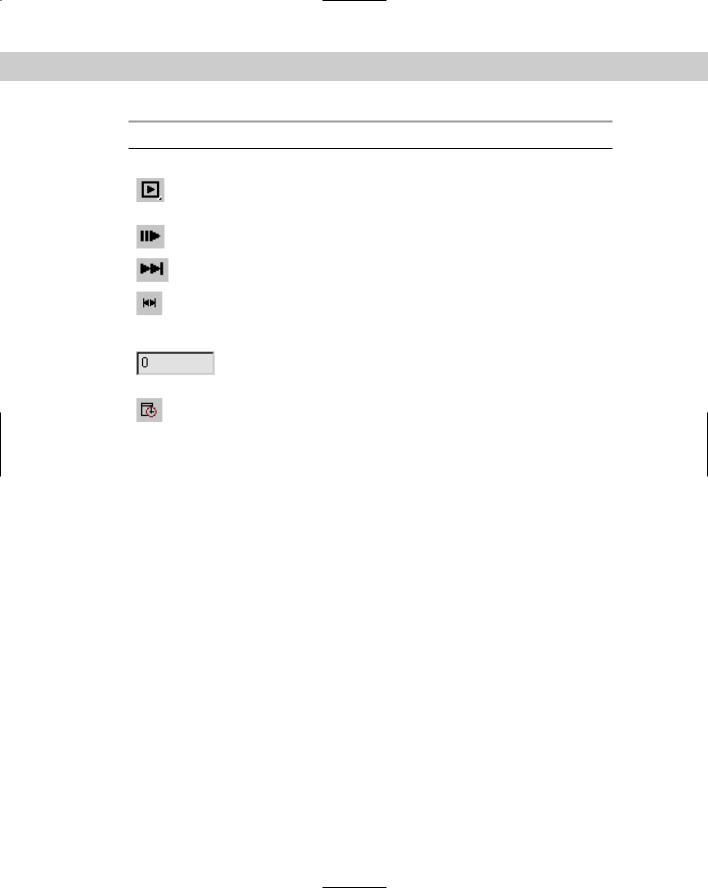
734 Part VII Animation
Table 30-1 (continued)
Toolbar Button |
Name |
Description |
|
|
|
|
Play Animation, Play Selected |
Cycles through the frames; this button |
|
|
becomes a Stop button when an animation is |
|
|
playing. |
|
Next Frame/Key |
Advances the time by one frame or selects the |
|
|
next key |
|
Go to End |
Sets the time to the final frame |
|
Key Mode Toggle |
Toggles between key and frame modes; with |
|
|
Key Mode on, the icon turns light blue and the |
|
|
Previous Frame and Next Frame buttons |
|
|
change to Previous Key and Next Key. |
|
Current Frame field |
Indicates the current frame; a frame number |
|
|
can be typed in this field for more exact |
|
|
control than the Time Slider. |
|
Time Configuration |
Opens the Time Configuration dialog box |
|
|
where settings like frame rate, time display, |
|
|
and animation length can be set |
|
|
|
The default scene starts with 100 frames, but this is seldom what you actually need. You can change the number of frames at any time by clicking the Time Configuration button, which is to the right of the frame number field. Clicking this button opens the Time Configuration dialog box, shown in Figure 30-1. You can also access this dialog box by right-clicking any of the Time Control buttons.
Setting frame rate
Within this dialog box, you can set several options, including the Frame Rate. Frame rate provides the connection between the number of frames and time. It is measured in frames per second. The options include standard frame rates such as NTSC (National Television Standards Committee, around 30 frames per second), Film (around 24 frames per second), and PAL (Phase Alternate Line, used by European countries, around 25 frames per second), or you can select Custom and enter your own frame rate.
The Time Display section lets you set how time is displayed on the Time Slider. The options include Frames, SMPTE (Society of Motion Picture Technical Engineers), Frame:Ticks, or MM:SS:Ticks (Minute and Seconds). SMPTE is a standard time measurement used in video and television. A Tick is 1⁄4800 of a second.

Chapter 30 Animation Basics 735
Figure 30-1: The Time Configuration dialog box lets you set the number of frames to include in a scene.
Setting speed and direction
The Playback section sets options for how the animation sequence is played back. The Real Time option skips frames to maintain the specified frame rate. The Active Viewport Only option causes the animation to play only in a single viewport, which speeds up the animation. The Loop option repeats the animation over and over. The Loop option is available only if the Real Time option is disabled. If the Loop option is set, then you can specify the Direction as Forward, Reverse, or Ping-Pong (which repeats playing forward and then reverse). The Speed setting can be 1⁄4, 1⁄2, 1, 2, or 4 times normal.
The Time Configuration dialog box also lets you specify the Start Time, End Time, Length, and Current Time values. These values are all interrelated, so setting the Length and the Start Time, for example, automatically changes the End Time. These values can be changed at any time without destroying any keys. For example, if you have an animation of 500 frames and you set the Start and End Time to 30 and 50, the Time Slider controls only those 21 frames. Keys before or after this time are still available and can be accessed by resetting the Start and End Time values to 0 and 500.
The Re-scale Time button fits all the keys into the active time segment by stretching or shrinking the number of frames between keys. You can use this feature to resize the animation to the number of frames defined by Start and End Time values.
The Key Steps group lets you set which key objects are navigated using key mode. If you select Use Track Bar, key mode moves through only the keys on the Track Bar. If you select the Selected Objects Only option, key mode jumps only to the keys for the currently selected object. You can also filter to move between Position, Rotation, and Scale keys. The Use Current Transform option locates only those keys that are the same as the current selected transform button.
Using Time Tags
To the right of the Prompt Line is a field marked Add Time Tag. Clicking this field pops up a menu with options to Add or Edit a Time Tag. Time Tags can be set for each frame in the scene. Once set, the Time Tags are visible in the Time Tag field whenever that time is selected.
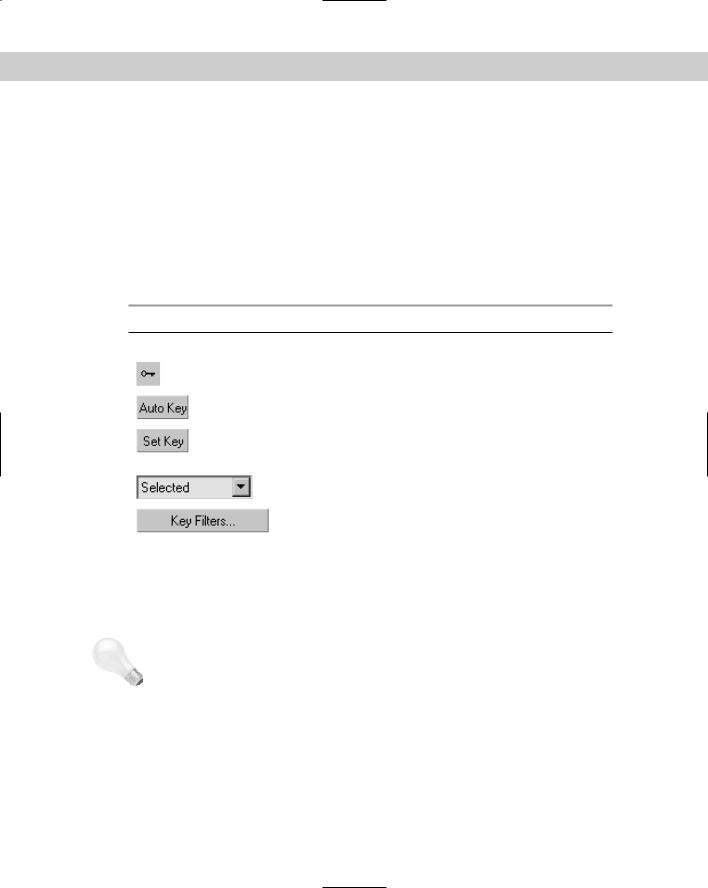
736 Part VII Animation
Working with Keys
It isn’t just a coincidence that the largest button in the entire Max interface has a key on it. Creating and working with keys is how animations are accomplished. Keys define a particular state of an object at a particular time. Animations are created as the object moves or changes between two different key states. Complex animations can be generated with only a handful of keys.
You can create keys in numerous ways, but the easiest is with the Key Controls found on the lower interface bar. These controls are located to the left of the Time Controls. Table 30-2 displays and explains all these controls. Closely related to the Key Controls is the Track Bar, which is located under the Time Slider.
Table 30-2: Key Controls
Toolbar Button |
Name |
Description |
|
|
|
|
Set Keys (K) |
Creates animation keys in Set Key |
|
|
mode |
|
Toggle AutoKey Mode (N) |
Sets keys automatically for the |
|
|
selected object when enabled |
|
Toggle Set Key Mode (') |
Sets keys as specified by the key |
|
|
filters for the selected object when |
|
|
enabled |
|
Selection Set drop-down list |
Specifies a selection set to use for |
|
|
the given keys |
|
Open Filters Dialog box |
Contains pop-up options for the |
|
|
filtering keys |
|
|
|
Max includes two different animation modes: Auto Key (N) and Set Key ('). You can select either of these modes by clicking the respective buttons at the bottom of the interface. When active, the button turns bright red, and the border around the active viewport also turns red to remind you that you are in animate mode. Red also appears around a spinner for any parameters that are animated.
Tip |
You can set the Time slider bar to be red as well by adding the following to the 3dsmax.ini file: |
[RedSliderWhenAnimating]
Enabled=1
Auto Key mode
With the Auto Key button enabled, every transformation or parameter change creates a key that defines where and how an object should look at that specific frame.
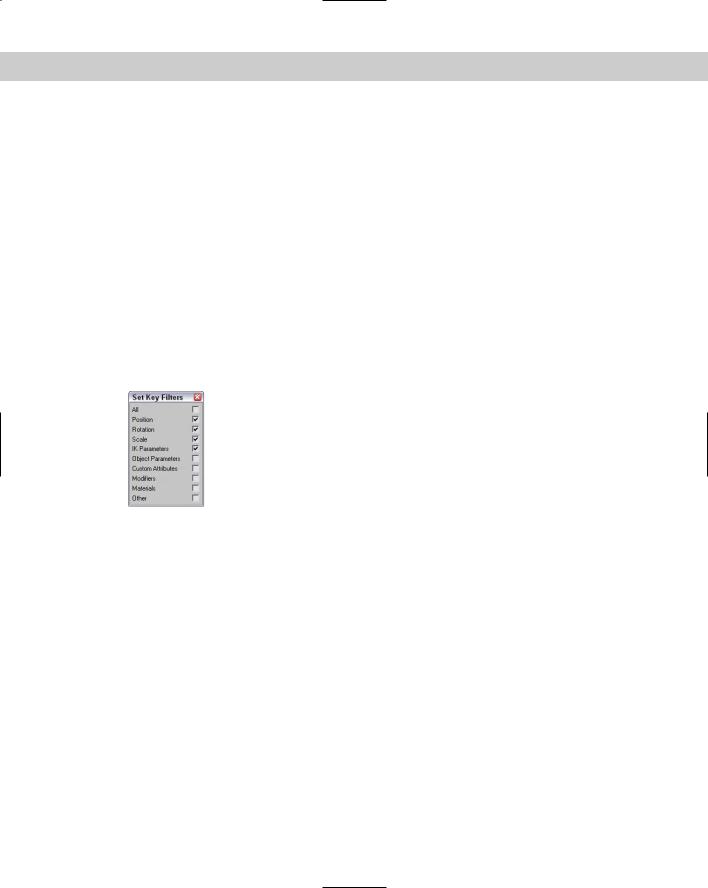
Chapter 30 Animation Basics 737
To create a key, drag the Time Slider to a frame where you want to create a key and then move the selected object or change the parameter, and a key is automatically created. When the first key is created, Max automatically goes back and creates a key for frame 0 that holds the object’s original position or parameter. Upon setting the key, Max then interpolates all the positions and changes between the keys. The key are displayed in the Track Bar.
Each frame can hold several different keys, but only one for each type of transform and each parameter. For example, if you move, rotate, scale, and change the Radius parameter for a sphere object with the Auto Key mode enabled, then a key is created for position, rotation, scaling, and a parameter change.
Set Key mode
The Set Key button (') offers more control over the key creation and sets keys only when you click the Set Key button (K). It also creates keys only for the key types enabled in the Key Filters dialog box. You can open the Key Filters dialog box, shown in Figure 30-2, by clicking the Key Filters button. Available key types include All, Position, Rotation, Scale, IK Parameters, Object Parameters, Custom Attributes, Modifiers, Materials, and Other (which allows keys to be set for manipulator values).
Figure 30-2: Use the Set Key Filters dialog box to specify the types of keys to create.
Tutorial: Rotating a windmill’s blades
The best way to learn is to practice, and there’s no better time to practice than now. For this quick example, you animate a set of blades on a windmill.
To animate a set of windmill blades rotating, follow these steps:
1.Open the Rotating windmill blades.max file from the Chap 30 directory on the CD-ROM. This file includes a windmill model created by Viewpoint Datalabs.
2.Click the Auto Key button (or press the N key) at the bottom of the Max window and drag the Time Slider to frame 50.
3.Select the “prop” object at the top of the windmill in the Front viewport. The blades are attached to the center prop and rotate about its Pivot Point. Then click the Select and Rotate button on the main toolbar (or press E key), and rotate the “prop” object about its Y axis.
4.Click the Auto Key button (or press the N key) again to disable animation mode. Select the key in the Track Bar located at frame 1, hold down the Shift key, and drag the key to frame 100 (or press the End key).
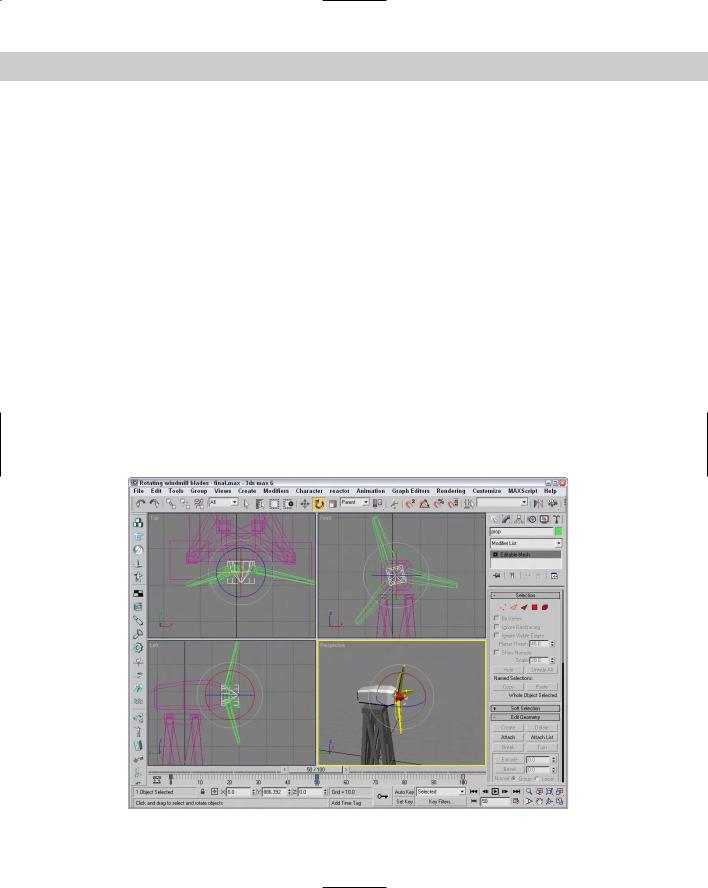
738 Part VII Animation
This step copies the key from frame 1 to frame 100. Doing so ensures a smooth looping animation (even though it spins the prop forward and then backward; I guess it must be a strange wind that’s blowing).
5. Click the Play Animation button in the Time Controls to see the animation.
Figure 30-3 shows frame 50 of this simple animation.
Creating keys with the Time Slider
Another way to create keys is to select the object to be animated and right-click the Time Slider button. This opens the Create Key dialog box, shown in Figure 30-4, where you can set Position, Rotation, and Scale keys for the currently selected object. You can use this method only to create transform keys.
If a key already exists, you can clone it by dragging the selected key with the Shift key held down. Dragging the Track Bar with the Ctrl and Alt keys held down changes the active time segment.
Copying parameter animation keys
If a parameter is changed while the Auto Key mode is enabled, then keys are set for that parameter. You can tell when a parameter has a key set because the arrows to the right of its spinner are outlined in red when the Time Slider is on the frame where the key is set. If you change the parameter value when the spinner is highlighted red, then the key value is changed (and the Auto Key mode doesn’t need to be enabled).
Figure 30-3: Frame 50 of this simple windmill animation
